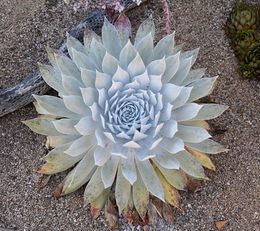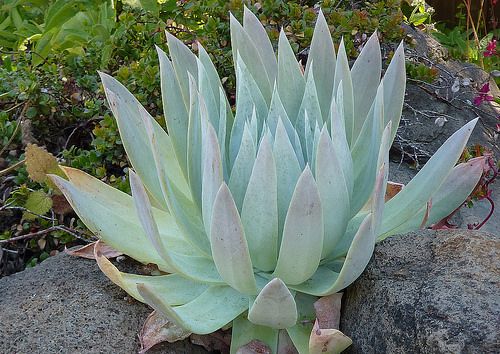Dudleya brittonii

Dudleya brittonii, commonly known as Britton's Beaked Dudleya, is a stunning succulent plant native to the rocky cliffs and canyons of Baja California, Mexico.
Renowned for its striking rosettes, vibrant colors, and adaptation to arid environments, this species holds both ecological and cultural significance.
In this comprehensive article, we will delve into the botanical intricacies, habitat preferences, life cycle, ecological importance, conservation status, and care guidelines for Dudleya brittonii.
Botanical Description
Britton's Beaked Dudleya is characterized by its tight rosettes of fleshy, spoon-shaped leaves arranged in a symmetrical pattern.
The leaves are often glaucous or bluish-green in color, with reddish or purplish margins that intensify in response to sunlight and stress.
The rosettes are typically compact and low-growing, although they may form larger clumps in favorable conditions.
In late spring to early summer, Dudleya brittonii produces tall, slender stems topped with clusters of small, star-shaped flowers in shades of orange, red, or yellow.
These vibrant flowers attract pollinators such as bees, butterflies, and hummingbirds, contributing to the plant's ecological role.
Habitat and Distribution
In the arid coastal regions of Baja California, Mexico, Britton's Beaked Dudleya thrives in rocky, well-drained habitats like cliffs and canyons.
Often, Britton's Beaked Dudleya grows alongside other succulent and desert-adapted plants, forming unique communities suited to extreme conditions.
Dudleya brittonii is endemic to specific areas within Baja California, including the Sierra de San Pedro Mártir and the Vizcaíno Desert, where it plays a crucial role in stabilizing soils and providing habitat for native wildlife.
Life Cycle and Phenology
As a perennial succulent, Dudleya brittonii follows a relatively simple life cycle influenced by seasonal changes in temperature and moisture.
New rosettes emerge from the base of the plant in late winter to early spring, triggered by longer daylight hours and warming temperatures.
Flowering typically occurs from late spring to early summer, with peak bloom periods varying depending on local climate conditions.
After flowering, the plant may produce offsets or "pups" at the base, allowing it to spread and form colonies over time.
Britton's Beaked Dudleya is well-adapted to the arid climate of Baja California, exhibiting a period of summer dormancy to conserve water during dry periods.
Ecological and Cultural Importance
Britton's Beaked Dudleya plays a vital ecological role as a habitat provider and soil stabilizer in arid environments.
The dense rosettes provide shelter and nesting sites for small animals and insects, while the flowers attract pollinators, contributing to the diversity of desert ecosystems.
Additionally, Dudleya brittonii has cultural significance as a symbol of resilience, beauty, and adaptation to harsh environments.
It is often admired by horticulturists, succulent enthusiasts, and gardeners for its ornamental value and ability to thrive in drought-tolerant landscapes.

Caring for Dudleya brittonii
Sunlight
Watering
Provide moderate water during the growing season, allowing the soil to dry out slightly between waterings to prevent root rot.
Avoid overwatering, especially during the plant's summer dormancy period.
Soil
Plant in well-drained, sandy or rocky soil with a neutral to slightly alkaline pH.
Dudleya brittonii prefers soil with good drainage and air circulation.
Mulching
Apply a thin layer of gravel or pebbles around the base of the plant to help retain moisture and suppress weeds.
Avoid covering the rosette with mulch, as this can trap moisture and lead to rot.
Pruning
Prune dead or damaged leaves as needed to maintain the health and appearance of the plant. Remove spent flower stalks after flowering to encourage new growth and prevent self-seeding.
Following these care guidelines enables cultivating vibrant Dudleya brittonii, preserving its iconic status and Baja California's desert biodiversity. Whether in gardens or containers, its allure endures.
Leave a Reply
You must be logged in to post a comment.